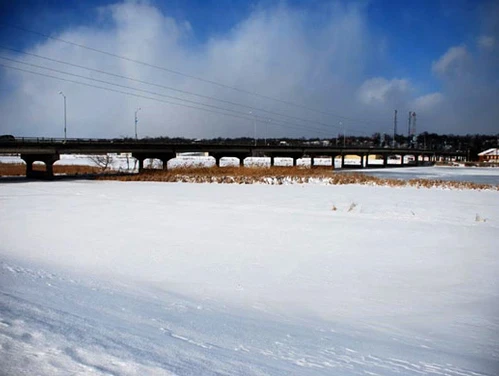- Year constructed: 1964
- Bridge type: Prestressed Concrete Stringer/Beam/Girder
- National Register of Historic Places status: Eligible
- Length: 2,319 feet
- Width: 56 feet
- Spans: 28
- FHWA: 050640
- Jurisdiction: Iowa DOT
- Location: 0.3 mile north of Jct. US 34 on Iowa 149 in Ottumwa, Section 24, T72N-R14W (Central Township)
Details
The project involved the relocation of U.S. Highway 34. In order to relocate the highway, the horseshoe bend of the Des Moines River was bypassed by a straightened channel over which the new bridge spanned. The bridge was designed by ISHC Chief Engineer L. M. Clauson. His design received an award for the most outstanding bridge design in Iowa using pre-stressed concrete (ISHC 1965:33). The 100' long beams in the center spans were the longest pre-tensioned, pre-stressed concrete beams used in Iowa. The bridge was used by the ISHC to test the camber of pre-tensioned, pre-stressed concrete beams in the field. Also, for the first time in Iowa, drilled caissons were used in pier construction instead of pile foundations to limit vibration effects to surrounding buildings (ISHC 1965:34). The contract for construction of piers 2-12 was awarded on October 3, 1961 to Jensen Brothers Construction Company of Des Moines for $186,730. The remainder of the bridge construction was let to the same company on April 3, 1963 for $1,389,295 (ISHC 1965:34).
As early as 1949, the ISHC was conducting traffic studies in Ottumwa to determine the principal routes of traffic and needs of residents in and around that city. The spatial relationship between the Des Moines River, railroads, downtown area, entrances into the city, and the steep topography made planning for highway improvements a challenge (ISHC 1949:1-2). The study recommended the relocation of U.S. Highway 63 and 34 and Iowa Highway 15 (ISHC 1949:46). As part of the City’s Master Plan, U.S Highway 34 on the east side of the city was relocated to Roemer Avenue in 1954. Ten years later, a new four-lane U.S. Highway 34 was constructed from Church Street in downtown Ottumwa to the western city limits (Ottumwa Courier Dec. 12, 1967:1). A new Des Moines River Bridge (FHWA #50640) and Wapello Street Viaduct provided access from the new highway into downtown. In September 1966, the four-lane U.S. 34/63 was completed from Church Street south to Mary Street (Ottumwa Courier Sept. 3, 1966:4). Grading for this section of the highway necessitated 1 million cubic yards of fill, which was hauled from the east side of the Des Moines River over a temporary bridge constructed by E. M Dusenberg Construction Company of Mason City (Ottumwa Courier July 14, 1965:1). Eight bridges were constructed along this segment of the highway (FHWA #50460-50530). The last segment of the highway relocation project was U.S. Highway 34 from the newly construction U.S. 34/63 north and east to Roemer Avenue (Ottumwa Courier Dec. 12, 1967:1). A second Des Moines River Bridge was constructed in this segment (FHWA #50540). On December 12, 1967, the completed U.S. Highway 34/63 relocation project was dedicated. A crowd of 200 “happy motorists” attended a ceremony on the new Des Moines River Bridge in southeast Ottumwa. The ISHC Vice-Chairman Derby Thompson and Ottumwa Mayor Lafe Dupy attended the dedication, which continued with a luncheon at the Red Lyon Inn (Ottumwa Courier Dec. 12, 1967:1).The total cost of the highway relocation project was $11 million (Ottumwa Courier Nov. 11, 1967:1).
The bridge was included in the Phase II survey as it is a large bridge of exceptional span or overall length, which according to the registration requirements in the MPD is a prestressed girder span (Type 502) with a span greater than 100’ or multiple span bridges with an overall length in excess of 400' in length. The bridge is 2319' long with a main span of 102', which meets both the aforementioned registration requirements for prestressed concrete bridges. As such, the US 63 Bridge is eligible for inclusion in the NRHP under Criteria A and C as it does meet the registration requirements outlined in the MPD . Though, the bridge is less than 50 years of age, it does possess characteristics of exceptional importance and thus does meet Criteria Consideration G. The bridge used the longest pretensioned, pre-stressed concrete beams used in Iowa.
Areas Served
- Wapello
